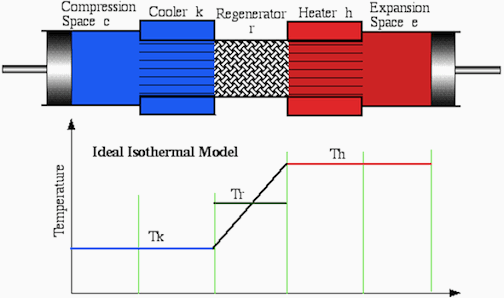
The invention of the Stirling engine in 1816 was well in advance of all pertinent scientific knowledge of that time. The first attempt at an analysis of the cycle was published in 1871 by Gustav Schmidt. Much as the Otto cycle has become the classic Air standard cycle to describe the spark ignition engine, the cycle described by Schmidt has become the classic ideal Stirling cycle. This is unfortunately mainly because the Schmidt analysis yields a closed form solution rather than its ability to predict the real cycle, however we use it as a starting point to guide us ultimately to a more realistic approach.
Consider the Ideal Isothermal model of a Stirling engine as shown below.
The principal assumption of the analysis is that the gas in the expansion space and the heater is at the constant upper source temperature and the gas in the compression space and the cooler is at the constant lower sink temperature. This isothermal assumption makes it possible to generate a simple expression for the working gas pressure as a function of the volume variations. This expression may then be used to investigate how different drive mechanisms affect the output power. To obtain closed form solutions, Schmidt assumed that the volumes of the working spaces vary sinusoidally.
The assumption of isothermal working spaces and heat exchangers implies that the heat exchangers (including the regenerator) are perfectly effective, with a spacial temperature distribution as indicated in the figure above. The engine is considered as a five component serially connected model, consisting respectively of a compression space c, cooler k, regenerator r, heater h and expansion space e. Each component is considered as a homogeneous entity or cell, the gas therein being represented by its instantaneous mass m, absolute temperature T, volume V and pressure p, with the suffix c, k, r, h, and e identifying the specific cell.
The starting point of the analysis is that the total mass of gas in the machine is constant, thus:
M = mc + mk + mr + mh + me
Substituting the ideal gas law given by
m = p V / R T
we obtain
M = p (Vc / Tk + Vk / Tk + Vr / Tr + Vh / Th + Ve / Th) / R
For the assumed linear temperature distribution in the regenerator we can show that the effective regenerator temperature Tr is given by
Tr = (Th - Tk) / ln(Th / Tk)
Thus given the volume variations Vc and Ve we can solve the above equation for pressure p as a function of Vc and Ve.
The work done by the system over a complete cycle is given respectively by the cyclic integral of p dV
On evaluating the heat transferred over a complete cycle to the various cells we find remarkably that the cyclic heat transferred to all three heat exchanger cells is zero! Thus:
Qc = Wc
Qe = We
Qk = 0
Qh = 0
Qr = 0
This rather startling result implies that all the heat exchangers in the ideal Stirling engine are redundant since all the external heat transfer occurs across the boundaries of the compression and expansion spaces. This apparent paradox is a direct result of the definition of the Ideal Isothermal model in which the compression and expansion spaces are maintained at the respective cooler and heater temperatures. Obviously this cannot be correct, since the cylinder walls are not designed for heat transfer. In real machines the compression and expansion spaces will tend to be adiabatic rather than isothermal, which implies that the net heat transferred over the cycle must be provided by the heat exchangers. This will be resolved when we consider the Ideal Adiabatic Model in the next section.
The set of pertinent equations is shown in the following table.
In order to solve these equations we need to specify the working space volume variations Vc and Ve as well as the respective volume derivatives dVc and dVe with respect to crankangle θ. One of the case studies of this course is the Ross Yoke-drive engine for which we have analyzed the volume variations, thus the above equation set can be solved by numerical integration. In 1871 Gustav Schmidt published an analysis in which he obtained closed form solutions for the above equation set for the special case of sinusoidal volume variations. We continue now with the Schmidt Analysis.
______________________________________________________________________________________
![]()
Stirling Cycle Machine Analysis by
Israel
Urieli is licensed under a Creative
Commons Attribution-Noncommercial-Share Alike 3.0 United States
License